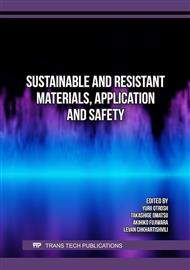[1]
Meng, W., Sun, H., & Su, G. (2023). Plastic packaging-associated chemicals and their hazards - An overview of reviews. Chemosphere, 331, 138795.
DOI: 10.1016/j.chemosphere.2023.138795
Google Scholar
[2]
Verma, R., Vinoda, K. S., Papireddy, M., & Gowda, A. N. S. (2016). Toxic Pollutants from Plastic Waste- A Review. Procedia Environmental Sciences, 35, 701-708.
DOI: 10.1016/j.proenv.2016.07.069
Google Scholar
[3]
Nkwachukwu, O. I., Chima, C. H., Ikenna, A. O., & Albert, L. (2013). Focus on potential environmental issues on plastic world towards a sustainable plastic recycling in developing countries. International Journal of Industrial Chemistry, 4.
DOI: 10.1186/2228-5547-4-34
Google Scholar
[4]
Klotz, M., Haupt, M., & Hellweg, S. (2023). Potentials and limits of mechanical plastic recycling. Journal of Industrial Ecology, 27, 1043–1059.
DOI: 10.1111/jiec.13393
Google Scholar
[5]
Muhammad Shamsuddin, I. (2017). Bioplastics as Better Alternative to Petroplastics and Their Role in National Sustainability: A Review. Advances in Bioscience and Bioengineering, 5(4).
DOI: 10.11648/j.abb.20170504.13
Google Scholar
[6]
Sun, X., He, M., & Li, Z. (2020). Novel engineered wood and bamboo composites for structural applications: State-of-art of manufacturing technology and mechanical performance evaluation. Construction and Building Materials, 249.
DOI: 10.1016/j.conbuildmat.2020.118751
Google Scholar
[7]
Ma, X., Luo, Z., Ji, C. H., Cai, L., & Fei, B. (2022). Flexural creep behaviors of bamboo subjected to different gradient variation directions and relative humidity. Industrial Crops and Products, 179.
DOI: 10.1016/j.indcrop.2022.114679
Google Scholar
[8]
Yuan, J., Fang, C., Chen, Q., & Fei, B. (2021). Observing bamboo dimensional change caused by humidity. Construction and Building Materials, 309.
DOI: 10.1016/j.conbuildmat.2021.124988
Google Scholar
[9]
Faris M. AL-Oqla, & Salit, M. S. (2017). Materials Selection for Natural Fiber Composites: Woodhead Publishing.
Google Scholar
[10]
Yiping, L., Li, Y., Buckingham, K., Henley, G., & Guomo, Z. (2010). Bamboo and Climate Change Mitigation (Vol. 32).
Google Scholar
[11]
Liese, W. (1987). Research on bamboo. Wood Science and Technology, 21(3), 189–209.
Google Scholar
[12]
Jakovljević,S., Lisjak, D., Alar, Ž., & Penava, F.(2017). The influence of humidity on mechanical properties of bamboo for bicycles. Construction and Building Materials, 150, 35-48.
DOI: 10.1016/j.conbuildmat.2017.05.189
Google Scholar
[13]
Yuan, J., Chen, Q., & Fei, B. (2021). Investigation of the water vapor sorption behavior of bamboo fibers with different sizes. European Journal of Wood and Wood Products, 79(5), 1131-1139.
DOI: 10.1007/s00107-020-01652-4
Google Scholar
[14]
Kadivar, M., Gauss, C., Mármol, G., de Sá, A. D., Fioroni, C., Ghavami, K., & Savastano, H. (2019). The influence of the initial moisture content on densification process of D. asper bamboo: Physical-chemical and bending characterization. Construction and Building Materials, 229.
DOI: 10.1016/j.conbuildmat.2019.116896
Google Scholar
[15]
Chen, G., & Luo, H. (2023). Effects of moisture content and fibrous structure on the uniaxial compression behavior of natural bamboo. Construction and Building Materials, 408.
DOI: 10.1016/j.conbuildmat.2023.133711
Google Scholar
[16]
Chakkour, M., Ould Moussa, M., Khay, I., Balli, M., & Ben Zineb, T. (2023). Effects of humidity conditions on the physical, morphological and mechanical properties of bamboo fibers composites. Industrial Crops and Products, 192.
DOI: 10.1016/j.indcrop.2022.116085
Google Scholar
[17]
Lessard, G., & Chouinard, A. (1980). Bamboo research in Asia : proceedings of a workshop held in Singapore, 28-30 May 1980.
Google Scholar
[18]
Li, X. B., Shupe, T. F., Peter, G. F., Hse, C. Y., & Eberhardt, T. L. (2007). Chemical changes with maturation of the bamboo species phyllostachys pubescens. Journal of Tropical Forest Science, 19, 6-12.
Google Scholar
[19]
Kaima, J., Preechawuttipong, I., Jongchansitto, P., & Charoenloe, N. (2020). Effect of Chemical Solution on Tensile Strength of Bamboo Fiber. Paper presented at the 10th TSME-International Conference on Mechanical Engineering (TSME-ICOME2019), Pattaya, Thailand.
DOI: 10.1088/1757-899x/886/1/012061
Google Scholar
[20]
Information on https://www.tmd.go.th
Google Scholar
[21]
Askarinejad, S., Kotowski, P., Shalchy, F., & Rahbar, N. (2015). Effects of humidity on shear behavior of bamboo. Theoretical and Applied Mechanics Letters, 5(6), 236-243.
DOI: 10.1016/j.taml.2015.11.007
Google Scholar
[22]
Osorio, L., Trujillo, E., Lens, F., Ivens, J., Verpoest, I., & Van Vuure, A. W. (2018). In-depth study of the microstructure of bamboo fibres and their relation to the mechanical properties. Journal of Reinforced Plastics and Composites, 37(17), 1099-1113.
DOI: 10.1177/0731684418783055
Google Scholar


